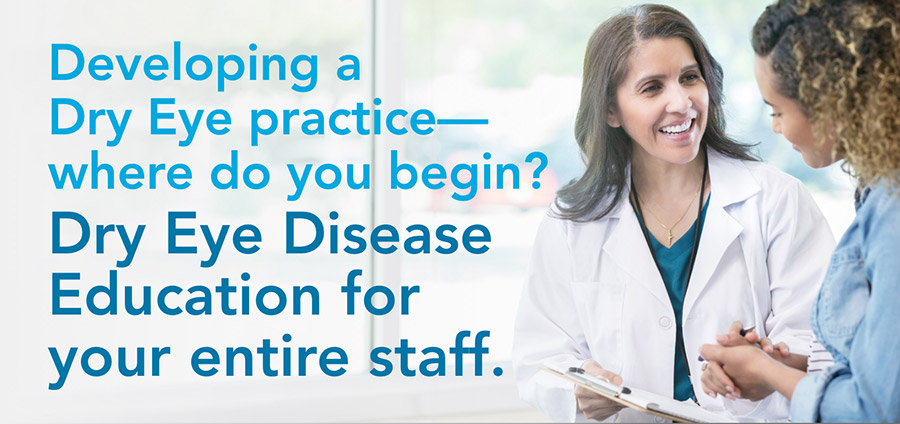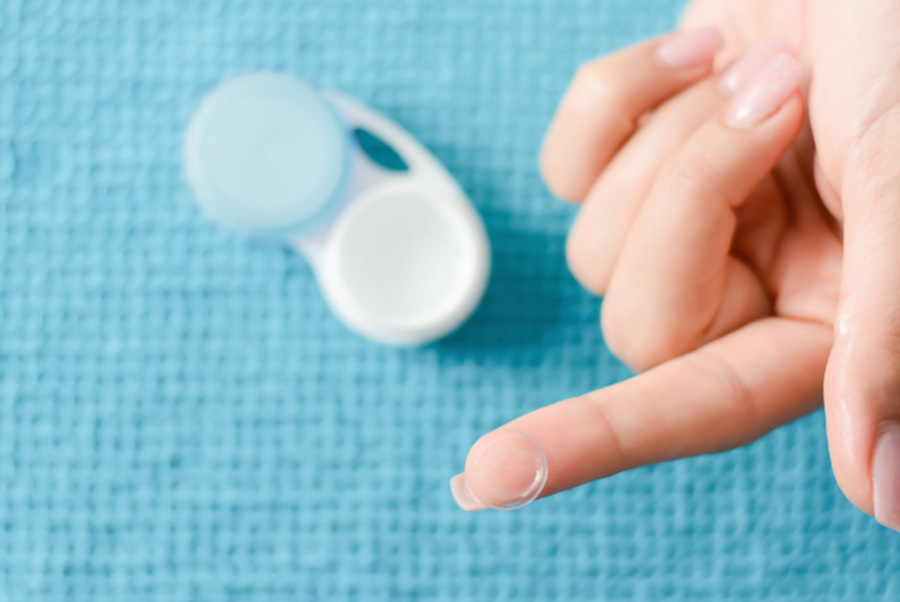Dry Eye Disease Education: Where to Start


Dry Eye Disease Education is Important—For Everyone
The Fundamentals
For every patient who walks in your office, you rely on your staff to treat them as you would—with knowledgeable responsiveness about the eye care services you provide. It’s no different with understanding the basics of Dry Eye Disease. Staff members need a general understanding of why their practice is taking on dry eye, and the importance of offering more comprehensive eye care for your patients.
To that end, you and your staff can quickly get up to speed on the fundamentals of Dry Eye Disease education in several ways. Throughout the site are content-rich articles that inform practice professionals about the nuances of the disease, including Connecting with Dry Eye Patients of Every Generation, why a Uniform Approach is important, and why every member of your staff should know the 4 Stages of Dry Eye Disease (1. Asymptomatic 2. Mild 3. Moderate 4. Severe).
Going Deeper
Once these Dry Eye Access articles have been read, logged in members can begin the Clinical Essentials Course, which includes 11 lessons on the fundamentals of Dry Eye Disease and the different types of Dry Eye Disease seen in your office each day. The first lesson, Defining Dry Eye Disease gives a basic overview, followed by Anatomy of Dry Eye Disease. Because these two lessons provide a solid foundation of understanding “the mechanics” of Dry Eye Disease, once they have been completed, the rest of the Clinical Essentials lessons can be taken in any order.
Not a member of Dry Eye Access?
For one annual membership, all of the members of your staff can take online educational courses, download practice resources, and learn about implementation tools that will help your practice adhere to a uniform approach of diagnosing and treating Dry Eye Disease.

Dry Eye Disease Education:
The Impact of “MultifactorialA number of different factors or causes involved.” Components
There are different types of Dry Eye Disease, and multifactorial reasons why a patient may present with more than a single type of dry eye. Moreover, when multiple factors are present, treatment becomes even more complex. Review the multifactorial components that contribute to the onset and progression of Dry Eye Disease, as well as the DEWSAlso known as the Dry Eye Workshop, the DEWS II panel created a contemporary evidence-based definition for Dry Eye Disease. II definition and possible findings during a Dry Eye Disease evaluation.
Mastering Contributing Factors
For Dry Eye Disease education, in-depth lessons on the primary contributing factors are found in the Clinical Essentials course. Issues impacting Dry Eye Disease include skin conditions, which is covered in the Defining Rosacea lesson; damage to the Meibomian GlandsA special kind of sebaceous glands at the rim of the eyelids that supply meibum. and the details of its prevalence are found in the lesson on Blepharitis, along with the anatomy behind the inflammation in the lesson, Innervation of the Meibomian Glands. Major challenges surround a hypersensitive immune system, and how the allergic cascade leads to inflammation, the “fuel” for Dry Eye Disease, found in Allergy-Related Dry Eye Disease. Other factors play their own roles in Dry Eye Disease types, comprehensively covered throughout the Clinical Essentials course.

Dry Eye Disease Education: Recognizing External Factors
What else is critical to learn in your Dry Eye Disease education? Understanding contributing external factors. For example, due to the many hours your patients spend on their devices (and the resulting slowed blink rate), clinicians are seeing an increased rate of Aqueous-Deficient Dry Eye Disease among young people, which is addressed in the lesson, Defining Aqueous Deficiency. Exposure to drying elements (sleeping under ceiling fans, CPAP machines) along with contact lens wear among those 45+ also contribute and can be found in the lesson, Exposure and Contact Lens-Related Dry Eye Disease. Maybe the biggest surprise is the role that cosmetics play in damaging sensitive oil glands, and how today’s application techniques contribute to makeup products migrating into tear film, the specifics of which are detailed in the lesson, Cosmetic BlepharitisA common ocular condition characterized by inflammation, scaling, reddening and rusting of the eyelid..

The Time to Start Dry Eye Disease Education is Now
Don’t hesitate to get you and your staff started on Dry Eye Disease education today. The lessons in the Clinical Essentials course are short (each averages less than 30 minutes), and although the subject matter may be sophisticated, the information provided in each can be understood by people of all education levels. Your staff will appreciate this “crash course” in the fundamentals of Dry Eye Disease education, offering a thorough understanding of why a focus on the many types of Dry Eye Disease has become a necessity to proactive eye care.
Once you and your staff have mastered the Clinical Essentials course, you’ll be ready to move on to the Diagnostics and Treatments course. Technicians will find these particular lessons useful. Lessons include Diagnostics, SPEED Questionnaire, and Therapeutic Instruments.
For your practice manager, our Practice Implementation course will be most helpful. It includes lessons on Planning Your Dry Eye Clinic, Facility Requirements, and Training. If you explore these advanced courses ahead of assigning them to your staff, you’ll be able to direct them to the most position-appropriate Dry Eye Disease education lessons.

Not a Member?
Join Dry Eye Access today!
Just one membership gives
Dry Eye Disease online learning, practice resources, and implementation tools to
your whole staff.
The lessons and courses mentioned here are provided by the experts at Bowden Eye & Associates and are featured in their comprehensive Dry Eye University events.
Become a Dry Eye Access Member Today!
As a member, you and your practice staff get online education, practice resources and implementation tools that will help you adhere to a uniform approach of diagnosing and treating Dry Eye Disease.

